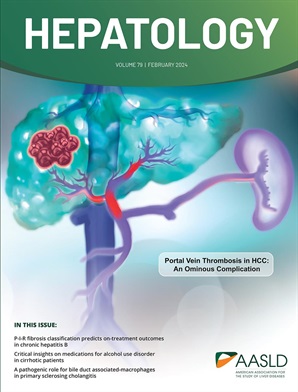Portal sinusoidal vascular diseases: Assessment and therapy
IF 12.9
1区 医学
Q1 GASTROENTEROLOGY & HEPATOLOGY
引用次数: 0
Abstract
The term porto-sinusoidal vascular disease (PSVD) was introduced in 2019 to describe a group of liver conditions that can lead to portal hypertension (PH) in the absence of cirrhosis or portal vein thrombosis, with or without specific findings on liver histology. The new nomenclature has facilitated the consolidation of knowledge on diseases previously referred to by various terms, including Banti’s disease, non-cirrhotic portal hypertension, non-cirrhotic portal fibrosis, and idiopathic portal hypertension, while excluding certain etiologies like sarcoidosis, congenital hepatic fibrosis, and Budd-Chiari syndrome. The prevalence and recognition of the disorder has been increasing. Advances in diagnostics and treatment have improved life expectancy for patients with associated conditions, such as immunodeficiencies and autoimmune diseases. Similar to cirrhosis, patients with PSVD may experience complications of PH, including variceal bleeding and ascites. However, less is known about its natural history, screening strategies, prognosis, and treatment options. This review discusses methods for assessing PSVD, including clinical and histological features, imaging techniques, and currently available treatments. It also addresses the challenges posed by the new nomenclature and the remaining questions in disease assessment.门窦血管疾病:评估与治疗
门窦血管疾病(PSVD)一词于2019年被引入,用于描述在没有肝硬化或门静脉血栓形成的情况下,有或没有肝脏组织学特异性发现的一组肝脏疾病,这些疾病可导致门脉高压(PH)。新的命名法有助于巩固以前用各种术语提及的疾病的知识,包括班提病、非肝硬化门静脉高压症、非肝硬化门静脉纤维化和特发性门静脉高压症,同时排除某些病因,如结节病、先天性肝纤维化和Budd-Chiari综合征。这种疾病的患病率和认知度一直在增加。诊断和治疗方面的进步提高了患有免疫缺陷和自身免疫性疾病等相关疾病的患者的预期寿命。与肝硬化类似,PSVD患者可能出现PH并发症,包括静脉曲张出血和腹水。然而,对其自然史,筛查策略,预后和治疗方案知之甚少。这篇综述讨论了评估PSVD的方法,包括临床和组织学特征、成像技术和目前可用的治疗方法。它还解决了新命名法带来的挑战和疾病评估中的剩余问题。
本文章由计算机程序翻译,如有差异,请以英文原文为准。
求助全文
约1分钟内获得全文
求助全文
来源期刊

Hepatology
医学-胃肠肝病学
CiteScore
27.50
自引率
3.70%
发文量
609
审稿时长
1 months
期刊介绍:
HEPATOLOGY is recognized as the leading publication in the field of liver disease. It features original, peer-reviewed articles covering various aspects of liver structure, function, and disease. The journal's distinguished Editorial Board carefully selects the best articles each month, focusing on topics including immunology, chronic hepatitis, viral hepatitis, cirrhosis, genetic and metabolic liver diseases, liver cancer, and drug metabolism.
 求助内容:
求助内容: 应助结果提醒方式:
应助结果提醒方式:


